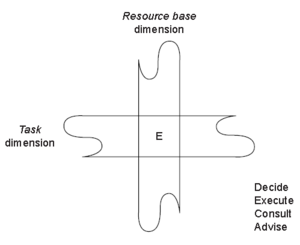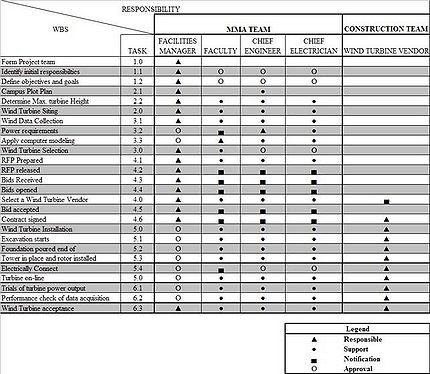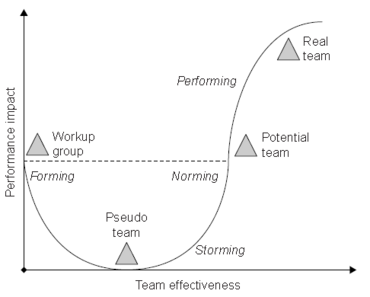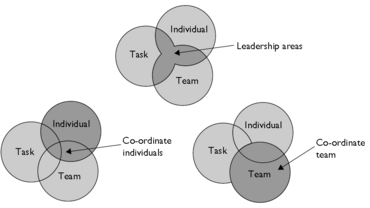Managing complex and temporary organizations
(→Limitations) |
(→Limitations) |
||
| Line 136: | Line 136: | ||
Even though good teamwork has proved to be an important key to an effective team, there is a lot of challenges to this. Since the world of construction consists of temporary building sites with temporary teams, a good teamwork will take a lot of time and cost from the project. And depending on the synergy of the group, reaching the ''real team'' in a group can take years, which is something that is not there in a construction project. This sometimes result in a lower prioritizing, since the time is limited, and also that time is money. | Even though good teamwork has proved to be an important key to an effective team, there is a lot of challenges to this. Since the world of construction consists of temporary building sites with temporary teams, a good teamwork will take a lot of time and cost from the project. And depending on the synergy of the group, reaching the ''real team'' in a group can take years, which is something that is not there in a construction project. This sometimes result in a lower prioritizing, since the time is limited, and also that time is money. | ||
| − | + | With that being said, teamwork gives value to the team as soon as the team has entered the phase of the ''potential team''. And since pseudo teams can be costly for a project, it is necessary in some degree to focus on the teamworking skills within the organization and its projects. This is a mindset that is slowly changing in the world of construction, but money has to be put into the process, especially in a constantly changing organization. Though, according to research<ref name=Winch <i>Graham M. Winch (2010), "Managing Construction | |
| − | Projects"</ref>, | + | Projects"</ref>, team-building is something that will give value to the teams and thereby the organizations. |
==Annotated bibliography== | ==Annotated bibliography== | ||
Revision as of 20:02, 19 June 2017
This article demonstrates how a team need to be constructed to be successful, and what it takes to make the group of a temporary but complex project work together as a team. The main concept of an organization will be explained, by looking at what is needed to work as a team that can fulfil the mission as efficient as possible. The article will look into what differences it makes, when the organization is not only temporary but also complex. In this case there is an end date to the work, but the organizations still need to interact as a team to be able to complete the task or mission.
To have a functional and effective organization, there needs to be a clear allocation of the responsibilities. How this is met, is run through by introducing the responsibility chart, thereby introducing DECA (Decide, Execute, Consult and Advise). Besides that, effective teamworking is introduced, by introducing a leader, a generator, an evaluator and lastly a finisher. Furthermore, requirements for how the team is put together needs to be met, since it neither should be to diverse nor to alike, this being referred to as the “manageable zone in teambuilding”. Lastly the team will develop over time, but how it will develop is both dependent on time and cost, which in the world of construction is limited. This, especially, is a challenge for temporary teams, but non the less important to improve and maintain.
Contents |
Organizations and teamwork
An organization can be defined as a group of people that is structured or managed to meet a need or pursue collective goals[1]. In order to have a healthy organization, roles and responsibilities must be assigned to each group member. But more importantly is the application of the teamwork concept to the group. A team can be descripted as a group of people given value to the group [2] given a collective goal and a variety of complementary skills. By working together as a team, the organization will achieve its goal more effectively by using each skill of the group members combined with good collaboration and communication. Thus, the effectiveness of a good teamwork should not be underestimated.
Unfortunately, investing in team building is costly, which often results in low prioritizing. But even though initial performance drops during team building[2], value will be added to the project on the longer run[3].

When creating an efficient project organization, responsibilities needs to be allocated, and this allocation creates the organizational breakdown structure (OBS). Because of the temporary nature of construction organizations, the process needs to be tackled very early in the life cycle, rather than being evolved naturally[2]. Even though the responsibilities will change through the life cycle due to the progress and change of working teams, the responsibility chart is a helpful way to identify task execution responsibilities.
A responsibility chart consists of[2] (see figure 1):
• An X axis of the resource bases forming the OBS
• A Y axis of the tasks to be executed derived from the work breakdown structure (WBS)
• A system of symbols to identify different types of responsibility for a specified task
A useful symbol system is DECA. DECA stands for[2]:
• Decide – the person with overall accountability for the task including deciding to start the task and declaring it completed
• Execute – the team responsible for executing the task
• Consult – the people who need to be consulted regarding aspects of task execution
• Advise – those people who need to know that the task has started, is in progress or finished, but without further input
The matrix is helpful e.g. to identify budgetary responsibilities. An example of a responsibility chart can be seen in figure 2. A responsibility chart is rather useful even in temporary and complex organizations, since the chart can be changed or extended during the project. When new people arrives on site, new professions or tasks can easily be added to the chart along with the assigned responsibility.

Four propositions of Winch
Winch mentions four propositions to achieve an effective teamwork[2]. The propositions are run through below.
Finite maximum size
Research has found that a finite maximum size for a team is between 5 to 7 members[2]. If the team grows to large, relationships will break down causing the team to fragment.
Complementary skills
Research has found that a mix of complementary skills within the group is necessary, both within technical skills required for task execution but also within teamworking skills[2]. Obviously, the team needs to consist of members with the necessary technical skills to fulfil the task, but it is also important that the members are not too alike, nor too different on team skills. Too alike team skills will cause “groupthink”, which will result in poor mind mapping and thereby solving skills, while too diverse team skills will cause conflicts. This is illustrated by figure 3.

Thus, to have an effective team, the diversity of the team needs to be in the "manageable zone". Furthermore, Winch describes the following characteristics as being necessary in a team[2]:
• A leader, that stays focused on the goal and that handles the individually needs of the team members
• A generator, that generates solutions to the task
• An evaluator, that evaluates the generator’s solutions
• A finisher, that makes sure all details are handled
Clear goals and appropriate incentives
Clear goals and appropriate incentives with an addition of mutual accountability is necessary for an effective teamwork. To make the team effective, it is important that the team members share the same goals and incentives. Though, a common goal will always be threatened by individual underlying interests or personal agendas. Therefore, it is very important to make each goal of the team members clear through team-building, see "Storming phase" in the next proposition.
Evolutionary circle

Every team goes through an evolutionary circle, whether team-building is prioritized or not. This is usually presented as a four-phase circle (Four Stages of Team Development):
• Forming, which is where the working group is being formed by putting individual members into a team
• Storming. Here each member will negotiate their position in the team. Personal agendas are revealed, and power struggles and conflicts are worked through. Though, sometimes a fully agreement is not met by all the participants, and conflicts will be hidden under false consensus. This phenomenon is called pseudo teams.
• Norming. Here norms are defined and also trust between members will be build-up. This is referred to as the potential team.
• Performing. This is the part where teamwork is added to the group through team-building, which causes the team to be more valuable than the sum of each individual member. This is referred to as the real team.
The last phase, performing, is only met through team-building. Since team-building is a cost, which in the beginning of the process is costing more than what it gives, it is sometimes not prioritized. But if team-building is prioritized, value will be added once the storming phase is over. By team-building pseudo teams can be avoided, which is very important in order to achieve a functional and effective group.
The evolutionary circle is illustrated by figure 4. Here the four phases are present, and it is seen how the performance impact de- or increase through the phases and team effectiveness.
Complex and temporary projects
In construction, teams are often formed from members of different organizations[5]. This can create a lot of conflicts, since the members, and the organizations of which the members belong to, not necessarily share the same interests. When building complex projects, it is necessary to sort out power struggles and reveal personal agendas, so that conflicts can be sorted out. This is where team-building comes in, and the four-phase evolutionary circle. Though, this can be challenging in the world of construction, since every construction project is a temporary project. This means that all members of the group will be separated within a few years. Putting money into team-building can thereby seem like a waste of money and time, but lots of research shows that the effectiveness of the team will increase with team-building. One reason for that, is that a team without trust will have a hard time reaching its full potential. Teamworking is for most parts about establishing interpersonal relationships, which will lead to better communication, trust and a better working environment. Thus, making it a better place to work and making the team more efficiently.
Conflicts and stress
As mentioned in the four propositions of Winch, complementary skills are needed to make a successful team. In construction, this is clearly seen when different kind of professions and organizations come together, to construct a project. This causes a lot of different interests, since the client has some wishes on how the building should be and what it should cost, the architects are trying to meet these ideas, while the engineer tries to make it buildable. This can create conflicts, i.e. when architects design something the engineers don’t find possible, or when the engineers or architects go above the cost the client was willing to put into the project.
There can be many reasons, but conflicts are always found where opinions or objectives differs[5]. Sometimes conflicts can be healthy, because they can create a positive competition, which can be beneficial since it improves productivity. Other times the conflicts will be unhealthy, and will lead to an unpleasant environment thus creating lower productivity. It is therefore of high importance that the project manager seeks to solve any conflicts, with team-building tools such as establishing a communication system and motivating towards reaching the common goals.
One way this can be done is by introducing partnering. In partnering a more open and honest environment is trying to be met, and every conflict is trying to be met by finding a win-win solution, which satisfies both parties.

According to Adair’s model (see figure 5), there are three aspects of leadership; Achieving the task, managing the team and managing individuals[5]. This means, that aside from managing the team, the project manager should also be able to focus on the managing of each individual. Though, this can be rather challenging, since people have different needs, and therefor might need different ways of motivation. This calls for different treatment of each member, but it is also important that all members feel equally treated. The project manager thereby needs to value differences and build on the different strengths, thereby increasing the complementary skills of the group and help the group go into “teamthink” rather than “groupthink” or “unmanageable conflicts”. Teamthink should be understood as a willingness to talk through the issues, to be creative and to encourage divergent views[5], and is therefore in the manageable zone in figure 1.
Stress is another thing which can cause the team to become more or less effective. Stress enhances the performance if it comes in small doses. If so, it can be used as a management tool[5]. But too much or too long periods of stress will cause a decrease in performance. To cope with this, organizational help can be introduced by teaching positive coping strategies.
A way to decrease both conflicts and stress is through communication.
Communication
Communication is key in a good teamwork, and it is very important for an efficient work. Unfortunately, communication is also a typical reason for conflicts.
In general, communication consists of a sender, a transmitter and a receiver. It is up to the sender of the message to choose an appropriate transmitter, so that the message is received and understood accurately[5]. The transmitter/medium can be e.g. by email, phone, presentation or just face-to-face. No matter the choice, this will always cause ‘noise’ to the message. For instance, a face-to-face talk can be very differently interpreted from people to people, since both tone and body language can influence the receiver differently. The past experiences of the receiver also have an influence and also the relationship between the sender and the receiver can make a difference. All this noise can create conflicts, and therefore good communication is key to a good teamwork. A way to avoid misunderstandings is by putting it into writing. This can e.g. be done in a minute of meeting, where whatever was agreed on in the meeting is put into writing, and all participants can sign it as an agreement. A meeting is also an effective way to interact and getting an equal message across to everyone[5].
Limitations
Even though good teamwork has proved to be an important key to an effective team, there is a lot of challenges to this. Since the world of construction consists of temporary building sites with temporary teams, a good teamwork will take a lot of time and cost from the project. And depending on the synergy of the group, reaching the real team in a group can take years, which is something that is not there in a construction project. This sometimes result in a lower prioritizing, since the time is limited, and also that time is money.
With that being said, teamwork gives value to the team as soon as the team has entered the phase of the potential team. And since pseudo teams can be costly for a project, it is necessary in some degree to focus on the teamworking skills within the organization and its projects. This is a mindset that is slowly changing in the world of construction, but money has to be put into the process, especially in a constantly changing organization. Though, according to research[2], team-building is something that will give value to the teams and thereby the organizations.
Annotated bibliography
1. Peter Fewings, "Construction Project Management", Taylor & Francis 2005. ISBN 0-203-00698-4 Master e-book ISBN.
The book focuses on project management in construction, and has several chapters dedicated to teamwork and project management, but especially chapter 7 is very useful for this topic, and is therefore highly recommended. Here different teamwork concepts are presented, and different studies are presented and commented on.
2. Stephen Emmitt and Christopher Gorse, "Communication in Construction Teams", Taylor & Francis 2007. ISBN10: 0–415–36619–4 (hbk).
This book focuses primarily on the communication and the importance of effective communication in a construction team. It states that without good communication finishing a construction process is almost impossible, and that focus on the important of good communication has been far too low and far too little research has been made on this topic. Therefore, this book make research of how the communication plays a role in teamworking.
3. Værdibyg, "Etablering af Samarbejde", Værdiskabende Byggeproces 2012.[6]
This handbook is about establishment of collaboration and has been prepared by a collaboration between various participants in the building industry of Denmark (e.g. Dansk Byggeri, Foreningen for Rådgivende Ingeniører, Danske Arkitekt Virksomheder etc.). The handbook focuses on the phase shift from project work to execution, and different tools to obtain a good relationship and collaboration is described.
4. Værdibyg, "Samarbejde og Kommunikation i Renoveringsprojekter", Værdiskabende Byggeproces 2015.[7]
This handbook is like the above reference about tools to achieve a good teamwork. It is developed by the same participants; the only difference is that this guidance focuses on the challenges in renovating projects.
References
- ↑ [http://www.businessdictionary.com/definition/organization.html] Businness dictionary
- ↑ 2.00 2.01 2.02 2.03 2.04 2.05 2.06 2.07 2.08 2.09 2.10 2.11 2.12 Graham M. Winch (2010), "Managing Construction Projects"
- ↑ Stephen Emmitt and Christopher A. Gorse (2007), "Communicating in Construction Teams"
- ↑ [http://www.hullwind.org/education.php] Hull Wind
- ↑ 5.0 5.1 5.2 5.3 5.4 5.5 5.6 5.7 Peter Fewings (2005), "Construction Project Management"
- ↑ Værdibyg (2012), "Etablering af Samarbejde", Online Handbook of Establishment of Collaboration. Retrieved 19.06.2017, Available Online
- ↑ Værdibyg (2015), "Samarbejde og Kommunikation i Renoveringsprojekter", Online Handbook of Collaboration and Communication in Renovating Projects. Retrieved 19.06.2017, Available Online